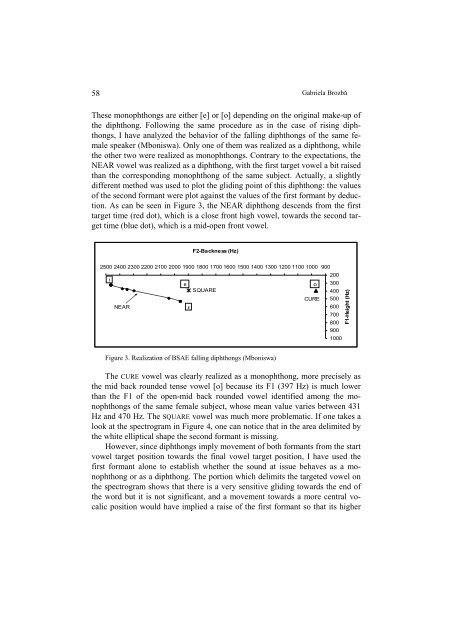s - Wyższa SzkoÅa Filologiczna we WrocÅawiu
s - Wyższa SzkoÅa Filologiczna we WrocÅawiu
s - Wyższa SzkoÅa Filologiczna we WrocÅawiu
Create successful ePaper yourself
Turn your PDF publications into a flip-book with our unique Google optimized e-Paper software.
58<br />
Gabriela Brozbă<br />
These monophthongs are either [e] or [o] depending on the original make-up of<br />
the diphthong. Following the same procedure as in the case of rising diphthongs,<br />
I have analyzed the behavior of the falling diphthongs of the same female<br />
speaker (Mboniswa). Only one of them was realized as a diphthong, while<br />
the other two <strong>we</strong>re realized as monophthongs. Contrary to the expectations, the<br />
NEAR vo<strong>we</strong>l was realized as a diphthong, with the first target vo<strong>we</strong>l a bit raised<br />
than the corresponding monophthong of the same subject. Actually, a slightly<br />
different method was used to plot the gliding point of this diphthong: the values<br />
of the second formant <strong>we</strong>re plot against the values of the first formant by deduction.<br />
As can be seen in Figure 3, the NEAR diphthong descends from the first<br />
target time (red dot), which is a close front high vo<strong>we</strong>l, towards the second target<br />
time (blue dot), which is a mid-open front vo<strong>we</strong>l.<br />
F2-Backness (Hz)<br />
2500 2400 2300 2200 2100 2000 1900 1800 1700 1600 1500 1400 1300 1200 1100 1000<br />
i<br />
NEAR<br />
e<br />
ǫ<br />
SQUARE<br />
o<br />
CURE<br />
900<br />
200<br />
300<br />
400<br />
500<br />
600<br />
700<br />
800<br />
900<br />
1000<br />
F1-Height (Hz)<br />
Figure 3. Realization of BSAE falling diphthongs (Mboniswa)<br />
The CURE vo<strong>we</strong>l was clearly realized as a monophthong, more precisely as<br />
the mid back rounded tense vo<strong>we</strong>l [o] because its F1 (397 Hz) is much lo<strong>we</strong>r<br />
than the F1 of the open-mid back rounded vo<strong>we</strong>l identified among the monophthongs<br />
of the same female subject, whose mean value varies bet<strong>we</strong>en 431<br />
Hz and 470 Hz. The SQUARE vo<strong>we</strong>l was much more problematic. If one takes a<br />
look at the spectrogram in Figure 4, one can notice that in the area delimited by<br />
the white elliptical shape the second formant is missing.<br />
Ho<strong>we</strong>ver, since diphthongs imply movement of both formants from the start<br />
vo<strong>we</strong>l target position towards the final vo<strong>we</strong>l target position, I have used the<br />
first formant alone to establish whether the sound at issue behaves as a monophthong<br />
or as a diphthong. The portion which delimits the targeted vo<strong>we</strong>l on<br />
the spectrogram shows that there is a very sensitive gliding towards the end of<br />
the word but it is not significant, and a movement towards a more central vocalic<br />
position would have implied a raise of the first formant so that its higher
















